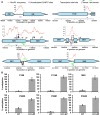Cell Cycle Constraints and Environmental Control of Local DNA Hypomethylation in α-Proteobacteria
- PMID: 27997543
- PMCID: PMC5172544
- DOI: 10.1371/journal.pgen.1006499
Cell Cycle Constraints and Environmental Control of Local DNA Hypomethylation in α-Proteobacteria
Abstract
Heritable DNA methylation imprints are ubiquitous and underlie genetic variability from bacteria to humans. In microbial genomes, DNA methylation has been implicated in gene transcription, DNA replication and repair, nucleoid segregation, transposition and virulence of pathogenic strains. Despite the importance of local (hypo)methylation at specific loci, how and when these patterns are established during the cell cycle remains poorly characterized. Taking advantage of the small genomes and the synchronizability of α-proteobacteria, we discovered that conserved determinants of the cell cycle transcriptional circuitry establish specific hypomethylation patterns in the cell cycle model system Caulobacter crescentus. We used genome-wide methyl-N6-adenine (m6A-) analyses by restriction-enzyme-cleavage sequencing (REC-Seq) and single-molecule real-time (SMRT) sequencing to show that MucR, a transcriptional regulator that represses virulence and cell cycle genes in S-phase but no longer in G1-phase, occludes 5'-GANTC-3' sequence motifs that are methylated by the DNA adenine methyltransferase CcrM. Constitutive expression of CcrM or heterologous methylases in at least two different α-proteobacteria homogenizes m6A patterns even when MucR is present and affects promoter activity. Environmental stress (phosphate limitation) can override and reconfigure local hypomethylation patterns imposed by the cell cycle circuitry that dictate when and where local hypomethylation is instated.
Conflict of interest statement
The authors have declared that no competing interests exist.
Figures






References
-
- Arber W, Dussoix D. Host specificity of DNA produced by Escherichia coli. I. Host controlled modification of bacteriophage lambda. J Mol Biol. 1962;5:18–36. - PubMed
MeSH terms
Substances
LinkOut - more resources
Full Text Sources
Other Literature Sources
Molecular Biology Databases

